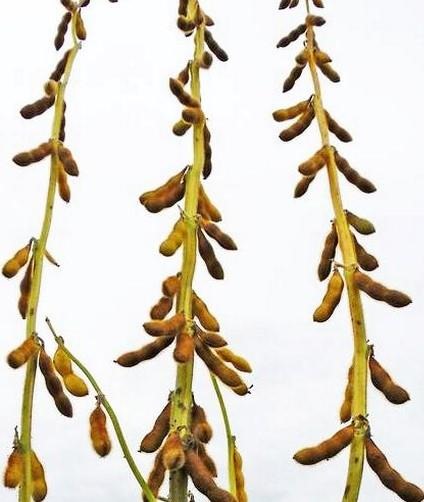By Michael Staton

Photo by Mike Staton, MSU Extension.
Michigan soybean producers have consistently identified planting rates as the highest priority topic to evaluate in on-farm replicated trials. Furthermore, the producers wanted to evaluate the effect of low planting rates on soybean yield and income. The two factors driving the increased interest in reducing soybean planting rates were seed cost and white mold. To help Michigan soybean producers make planting rate decisions, the soybean on-farm research program conducted a total of 67 on-farm replicated trials from 2015 to 2021. See Figure 1 for the trial locations.
Four target planting rates (80,00, 100,000, 130,000 and 160,000 seeds per acre) were compared at all but one location where the lowest rate was not included. Stand counts were taken to determine actual final plant stands at each location in all years. None of the varieties planted in the trials were straight line or thin line plant types and a complete seed treatment was used at 52 of the locations.
 Figure 1. Planting rate trial locations.
Figure 1. Planting rate trial locations.Because we conducted the trials over seven years, we learned how the planting rates performed over a range of growing conditions. Planting conditions were nearly ideal in 2015 but were much more challenging in 2017, 2018, 2019 and 2020 as evidenced by the average stand loss shown in Table 1. Statewide record yields were achieved in 2015 and again in 2016 and nearly again in 2021. However, lower yields occurred in 2017 due to excessive early rains and a lack of rain in August and September and in 2019 due to planting delays and dry weather in August.
Table 1. Average stand loss in the planting rate trials |
|---|
Year | Average stand loss for all planting rates (percent) |
|---|
2015 | 12 |
2016 | 18 |
2017 | 22 |
2018 | 26 |
2019 | 22 |
2020 | 23 |
2021 | 21 |
Table 2 shows the average yield and income for all 67 locations. When all 67 sites were combined, the yields from the highest two planting rates were identical and they beat the 100,000 seeds per acre planting rate by one bushel per acre and the 80,000 rate by only 2.7 bushels per acre. The 100,000 and 130,000 planting rates generated the most income while the 80,000 and 160,000 planting rates produced the least income.
Table 2. Planting rate effects on average yield and income from 2015 to 2021 (all 67 locations) |
|---|
Planting rate | Average yield (bu/ac) | *Gross income – seed cost ($/ac) |
|---|
80,000 | 60.1 c | $747 |
100,000 | 61.7 b | $759 |
130,000 | 62.5 a | $756 |
160,000 | 62.8 a | $748 |
*Soybean market price of $13 per bushel and a seed cost of $60 per 140,000 seed unit.
The effects of soybean planting rates on yield and income by year are shown in Figure 2. The bars represent yield and the lines represent income. To calculate the income (gross income minus seed cost) generated by each planting rate, we used the USDA projected prices and average seed costs for treated seed for each year. The figure clearly shows the year-to-year variability in yield and income. It also shows that the highest planting rate was frequently the least profitable.
 Figure 2. Planting rate effects on soybean yield and income from 2016 to 2021.
Figure 2. Planting rate effects on soybean yield and income from 2016 to 2021.Two of the trials were infested with white mold showing that reducing soybean planting rates can also be an effective management practice for reducing yield and income losses from white mold (Table 3). At both sites, the lowest planting rate produced $100 per acre more income than the highest planting rate. Figure 3 shows how planting rates affected white mold in the 2018 Saginaw location. This site was planted in 30-inch rows.
Table 3. Soybean planting rate effects on yield and income at two locations infested with white mold. |
|---|
Planting rate | Yield (bu/ac) | Income ($/ac) |
|---|
2015 Sanilac 2 | 2018 Saginaw | 2015 Sanilac 2 | 2018 Saginaw |
|---|
80,000 | 63.2 a | 66.2 a | $788 | $827 |
100,000 | 61.1 b | 66.5 a | $751 | $822 |
130,000 | 61.5 b | 64.3 a | $744 | $780 |
160,000 | 57.9 c | 61.2 b | $685 | $728 |
LSD 0.10 | 1.7 | 2.4 | | |
*Soybean market price of $13 per bushel and a seed cost of $60 per 140,000 seed unit.
 Figure 3. Drone image showing planting rate effects on white mold incidence at the 2018 Saginaw trial.
Figure 3. Drone image showing planting rate effects on white mold incidence at the 2018 Saginaw trial.This article was produced by a partnership between Michigan State University Extension and the Michigan Soybean Committee.
Source : msu.edu